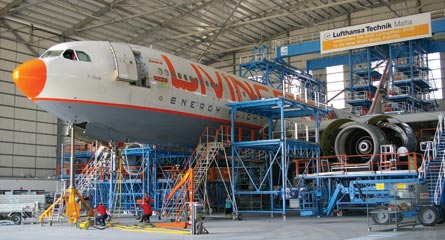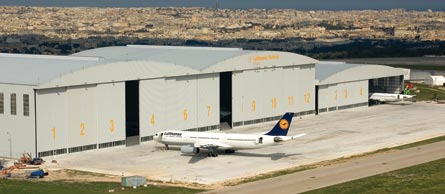The Mediterranean archipelago of Malta acceded to the European Union in 2004 and joined the eurozone currency bloc in 2008.
Not far on either side of these two national milestones, there were landmark events in the history of Lufthansa Technik Malta (LTM), which put the southern European country on the map as an aircraft maintenance location and nurtured a local industry set to gain in size when SR Technics opens for business near its Luqa airport base later this year.
It was in early 2003 that the Lufthansa Technik-Air Malta joint venture began operations as a one-hangar narrowbody maintenance specialist carrying out base maintenance C checks on Airbus A320 and Boeing 737 twinjets.
|
|---|
In late 2008, with 350 checks under its belt, it diversified its business by opening a new hangar dedicated to widebody maintenance, following through on a decision taken in 2006 - also the year in which it first carried out two simultaneous narrowbody C checks.
By the end of August, LTM had carried out nine C4 heavy checks of Airbus A330 widebodies and 22 C checks of A330s and A340s, while the total of narrowbody C checks had climbed to 463, with 20 more scheduled for completion by the end of the year.
Investment in the new widebody facility amounted to €55 million ($70 million). As part of a financing arrangement, Lufthansa Technik increased its share in the Maltese venture - which was initially 51% - to the 92% it holds today.
The upshot of the widebody hangar project is that Malta - with its population of around 400,000 - is now the home of Lufthansa's largest European maintenance subsidiary, by hangar space, outside Germany.
LTM can accommodate three narrowbodies and two widebodies simultaneously within its 24,000m2 (258,000ft2) of hangar space, which is supplemented by work shops spanning 36,000m2. Alongside microchip manufacturer ST Microelectronics and various pharmaceutical companies, LTM is a growing player in its nation's technical sector.
"The government is always willing to hear us and support us in whichever way is possible," says LTM chief executive Louis Giordimaina.
|
|---|
NETWORKING
Malta was only one of a number of locations LHT considered when, around the turn of the millennium, it was seeking a low-cost European location for low-margin, labour-intensive narrowbody airframe maintenance.
In 2001, as part of the evaluation process, it contracted Air Malta to carry out 737 checks, setting targets that pertained to quality, turnaround time and cost. Performance was sufficient for LHT to formalise a joint venture deal with the airline in June 2002.
While there are lower-cost destinations elsewhere in Europe, Malta was deemed to offer LHT what Giordimaina terms "a whole package" of attractions, including stable government, tax breaks available early in a venture's life, local technical training colleges and widely dispersed English language skills.
LHT's Maltese subsidiary sits within the product division focused on aircraft base maintenance. This also includes subsidiaries in Hungary (Budapest), Bulgaria (Sofia), Ireland (Shannon) and the Philippines (Manila), each of which has a particular specialism. The Sofia site, for example, carries out heavy maintenance of narrowbody types, while in Malta the focus is on C checks and modifications.
In widebody maintenance, LTM has heavy check capability on the A330 and expects to have the same for A340s by the end of the year. The company expanded a one-line widebody operation to a two-line one in the last quarter of 2009.
In 2003, work subcontracted by Lufthansa Technik accounted for about 75% of the volume handled by LTM. Independently sourced third-party business grew its share towards 50% in the years that followed, before falling back to a 20% share in 2009 and 2010.
"We, at the end of the day, form part of the Lufthansa Technik group," notes Giordimaina. "What we try to avoid is a lot of duplication, so primarily the sales division is centralised in Hamburg."
CAPABILITIES
While LTM continues to maintain 737 capability - and is serving Oman Air with C checks on the type - the A320 is the main driver of its narrowbody volumes. With its widebody focus similarly on the Airbus types, its capabilities largely mirror those of Lufthansa Technik Philippines, an Airbus maintenance specialist that launched in 2000.
However, LTM at the beginning of August began work on a standalone project pertaining to Boeing service bulletin (SB) 737-53A1177. Relevant to 737 classic aircraft, this SB specifies procedures for inspecting lap joints for signs of cracking and repairing any cracks detected, modifying tear-strap splice straps, and inspecting and repairing the fastener holes of the window corner of the lap joint area.
Within a nose-to-tail programme scheduled to run until 2014, LTM is processing 737-300 and -500 aircraft in Lufthansa's fleet at a rate of two a month. The work is being conducted at its original facility, which has been fitted with the required docking and equipment. LTM intends to market the capability to third-party customers.
US Federal Aviation Administration airworthiness directive AD 2002-07-08 directs that the SB 737-53A1177 inspections - and, if necessary, repairs - be carried out before an aircraft accumulates 50,000 cycles. As a successor to AD 97-22-07, it is intended to prevent fatigue cracking that could result in sudden decompression.
In 1988, an Aloha Airlines 737-200 lost the upper part of its entire forward fuselage from just behind the flightdeck while in cruise at 24,000ft (7,300m), causing an attendant to be swept overboard. The US National Transportation Safety Board attributed the accident to the failure of the Aloha Airlines maintenance programme to detect the disbonding and fatigue damage that led to failure of a lap joint. Its report drew attention to human factors in maintenance.
STAFFING UP
Lufthansa is of course the biggest airline customer of LTM, which also conducts C check maintenance of Air Malta's 12 A320-family aircraft. Other regular customers for LTM's maintenance services have included Aegean Airlines, Bluebird Cargo, BMI, Eurocypria, Germanwings, Qatar Airways, Spanair and Windjet. For Etihad Airways, first-class cabin reconfigurations of A340s have been carried out by LTM.
Naturally, LTM has felt the impacts of the economic downturn. "Where previously you might have seen customers with long-term contracts, now everyone's shopping around, not necessarily for a one-year contract, but sometimes even from one check to the other," says Giordimaina.
"That is what I would call one of the number-one challenges that we have as a facility over here," he adds.
Nevertheless, the expectation of ongoing growth plainly underpins LTM's staffing plans. By 2008, it had increased its employee numbers from an initial 110 to 160, and since then a major recruitment drive has taken the company to a workforce of 560 - most of them alumni of the Malta College of Arts, Science & Technology, and some veterans of Malta's shipyards. Annual production capacity runs to some 750,000 man-hours, and is set to increase, with the staff level due to reach 600 within 18 months.
SR TECHNICS FOLLOWS ITS RIVAL TO MALTA
MALTA's "stable political and financial environment", combined with labour rates lower than those typical of western Europe, lay behind SR Technics' decision to locate a narrowbody facility there.
The Mubadala-owned maintenance provider will launch its Maltese operations in October, using a two-bay hangar it is leasing from Medavia while a new four-bay hangar is being constructed. An EasyJet Airbus A320-family aircraft is to be the first airliner serviced at SR Technics' Maltese site, followed by another six aircraft by the end of the year and around 25 next year.
"This is not simply about setting up a lower-cost facility for routine work, but about replicating the SR Technics brand in Malta," says the company, which considered 53 locations in Europe before picking Malta.
In addition to Malta's stability, SR Technics cites as a factor in its decision the presence of "a significant number of potential customers within a 4h ferry flight radius". It cites also "a potential workforce with the relevant skills and qualifications, available locally".
The importance of competitive labour rates should not, however, be downplayed. By the company's own admission, a "competitive disadvantage" lies in SR Technics' "high operating costs", which it says are "primarily due to its major operations being located in countries in western Europe where labour costs are among the highest in the world".
In the course of a restructuring process set in train last year, SR Technics closed its Dublin operation and relocated component services business from London Stansted to its Zurich facilities, where it is focusing on high-value and specialised work in acknowledgement of a high cost base.
In this context, it expects the opening of a new facility in a lower-cost region to "substantially increase SR Technics' competitiveness in the labour-intensive airframe maintenance segment". Custom will be sought not only from legacy and low-cost airlines in Europe and the Middle East, but from aircraft lessors requiring "storage, end-of-lease workscopes, engineering services and standard maintenance workscopes".
While capabilities at the site will initially be confined to A320-family aircraft, Boeing 737 services will be offered once the new four-bay hangar is ready. Scheduled to reach fruition in early 2012, the infrastructural project is being supported by Malta Enterprise and Malta Industrial Park, partners which will also be involved in education and training of employees. SR Technics anticipates creating "up to 350 jobs" in Malta by 2014.
In three rounds of recruitment conducted earlier this year, around 130 employees came on board, from 1,200 applicants.
"We follow a non-poaching policy," stresses SR Technics.
Source: Flight International

























